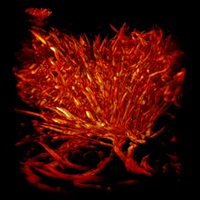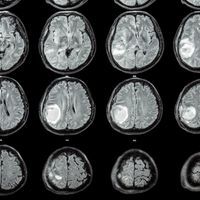brain cancer

Death by Stem Cell: Developing New Cancer Therapies
Charlene Lancaster, PhD | Jul 24, 2023 | 3 min read
Khalid Shah engineers stem cells to deliver cancer therapeutics directly to tumors, thereby increasing their efficacy.

Human Brain Organoids Transplanted Into Rats Respond to Visual Stimuli
Katherine Irving | Feb 3, 2023 | 3 min read
The organoids could one day be used to treat brain injuries in humans.

Infographic: A Brain Implant Stops Tumor Growth in Rats
Holly Barker, PhD | Dec 12, 2022 | 1 min read
The new, implantable device converts ultrasound waves into electrical energy inside the brain, interfering with tumor cell division.

Implantable Device Zaps Cancer Cells Using Electric Fields
Holly Barker, PhD | Dec 12, 2022 | 3 min read
A wireless brain implant inhibits tumor growth in rats, overcoming many design flaws of current devices used to treat glioblastoma.

Astrocytes Feed Glioblastoma, Promoting Tumor Growth: Mouse Study
Patience Asanga | Oct 5, 2022 | 3 min read
Starving glioblastoma tumors of the cholesterol made by astrocytes could suppress brain cancer progression.

Humsa Venkatesh Probes Cancer’s Grip on the Brain
Maddie Bender | Aug 15, 2022 | 3 min read
At Brigham and Women’s Hospital, the cancer biologist is combining research into the tumor microenvironment with the principles of neuroscience to tease apart how cancers grow—and how to stop them.

Glioblastoma Cells Imitate Immature Neurons to Invade the Brain
Sophie Fessl, PhD | Aug 5, 2022 | 3 min read
Neuron-like glioblastoma cells are the pioneers of deadly tumors’ spread through the brain, contributing to their devastating invasiveness, a study in mice finds.

Sound Waves Aid Brain Tumor Treatment
Ruth Williams | Oct 13, 2021 | 3 min read
In a small clinical study, focusing ultrasound beams on tumors in patients’ brains helped open the blood-brain barrier to facilitate drug delivery.

Microscopic Robots Deliver Drugs to the Brain
Asher Jones | Mar 30, 2021 | 5 min read
Researchers turned white blood cells called neutrophils into drug-smuggling “neutrobots,” which penetrated the blood-brain barrier to treat brain cancer in mice.

Best of Cancer Research
The Scientist | Sep 23, 2020 | 1 min read
This collection of articles from The Scientist explores some of the latest cancer research!

Image of the Day: Tumor Vasculature
Amy Schleunes | Jan 24, 2020 | 2 min read
Researchers use a cutting-edge technique to map the blood vessels of brain tumors as patients are awake during surgery with the hope of reducing damage to adjacent tissues.

Air Pollution Tied to Brain Cancer: Study
Emily Makowski | Nov 13, 2019 | 2 min read
Inhaling combustion-produced particles may lead to the development of brain tumors.

Aggressive Cancers Feed Off the Brain’s Nerves
Emily Makowski | Sep 20, 2019 | 2 min read
Three studies show that tumor cells can behave like neurons.

Immune-Activating Gene Therapy for Glioblastoma
Ruth Williams | Aug 14, 2019 | 3 min read
The results of an early trial in 31 brain cancer patients finds immune activity boosted in the tumor, and possibly longer survival.

Glioblastoma on a Chip
Jef Akst | Jul 15, 2019 | 3 min read
Researchers use 3-D printing technology to construct a brain cancer model that accurately recapitulated in vivo biology and predicted patient drug responses.

The Next Frontier of CAR T-Cell Therapy: Solid Tumors
Kerry Grens | Apr 1, 2019 | 10+ min read
The technology has wowed the field by all but obliterating some patients’ blood cancers, but solid malignancies present new challenges.

Study Finds “Some Evidence” that Cellphone Radiation Linked to Brain Cancer in Male Rats
Ashley P. Taylor | Nov 5, 2018 | 2 min read
The results cannot be extrapolated to humans, researchers caution.

Poliovirus Therapy May Extend Lives of Advanced Brain-Cancer Patients
Ashley Yeager | Jun 26, 2018 | 2 min read
More than one-fifth of individuals treated with the genetically modified virus survived at least three years.

A Neuroscientist’s Journey Through Madness
Barbara Lipska with Elaine McArdle | Apr 1, 2018 | 3 min read
After I was diagnosed with brain cancer and started to lose my mental health, the importance of my job came into clear focus.
